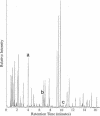Fermented beverages of pre- and proto-historic China
- PMID: 15590771
- PMCID: PMC539767
- DOI: 10.1073/pnas.0407921102
Fermented beverages of pre- and proto-historic China
Abstract
Chemical analyses of ancient organics absorbed into pottery jars from the early Neolithic village of Jiahu in Henan province in China have revealed that a mixed fermented beverage of rice, honey, and fruit (hawthorn fruit and/or grape) was being produced as early as the seventh millennium before Christ (B.C.). This prehistoric drink paved the way for unique cereal beverages of the proto-historic second millennium B.C., remarkably preserved as liquids inside sealed bronze vessels of the Shang and Western Zhou Dynasties. These findings provide direct evidence for fermented beverages in ancient Chinese culture, which were of considerable social, religious, and medical significance, and help elucidate their earliest descriptions in the Shang Dynasty oracle inscriptions.
Figures



References
-
- McGovern, P. E. (2003) Ancient Wine: The Search for the Origins of Viniculture (Princeton Univ. Press, Princeton).
-
- Vallee, B. L. (1998) Sci. Am. 278 (6), 80–85. - PubMed
-
- Underhill, A. P. (2002) Craft Production and Social Change in Northern China (Kluwer, New York).
-
- Dietler, M. &. Hayden, B., eds. (2001) Feasts: Archaeological and Ethnographic Perspectives on Food, Politics, and Power (Smithsonian Institution, Washington, DC).
-
- Huang, H.-T. (2000) in Science and Civilisation in China, ed. Needham, J., (Cambridge Univ. Press, Cambridge, U.K.), Vol. 6, pp. 151–153, 155–203, 232, 240–242, 247–248, and 258–282.
Publication types
MeSH terms
LinkOut - more resources
Full Text Sources

